Introduction
1. Understanding Mortgage Refinancing
1.1 Definition and Purpose
Mortgage refinancing is the process of replacing an existing mortgage with a new loan, often with more favorable terms. The primary purpose is to save money over the life of the loan by securing lower interest rates, reducing monthly payments, or changing the loan duration. Homeowners may choose to refinance for various reasons, including taking advantage of lower interest rates, consolidating debt, or accessing equity for home improvements or other financial needs.
1.2 Types of Refinancing
There are several types of mortgage refinancing options available to homeowners. Rate-and-term refinancing involves replacing an existing mortgage with a new loan that has better interest rates or terms, without taking additional cash out. Cash-out refinancing allows homeowners to borrow against the equity in their home by taking out a new loan for more than the existing mortgage balance. Streamline refinancing, often offered by government-backed loan programs like FHA or VA loans, simplifies the refinancing process by reducing paperwork and underwriting requirements.
2. Factors Influencing Refinancing
2.1 Interest Rates
Interest rates play a significant role in determining whether refinancing is a viable option for homeowners. When interest rates are low, homeowners may be able to secure a new mortgage with a lower rate, resulting in potential savings over the life of the loan. However, it’s essential to consider closing costs and other fees associated with refinancing to determine the overall benefit.
2.2 Credit Score
A borrower’s credit score is another critical factor that influences refinancing eligibility and terms. Lenders typically offer better rates and terms to borrowers with higher credit scores, as they are considered less risky. Before refinancing, homeowners should review their credit reports, address any inaccuracies, and take steps to improve their credit score if necessary.
2.3 Equity Position
The amount of equity homeowners have in their property also affects their ability to refinance. Equity is the difference between the current market value of the home and the remaining balance on the mortgage. Lenders often require a minimum amount of equity to qualify for refinancing, and homeowners with higher equity positions may be eligible for better loan terms and interest rates.
3. Benefits of Refinancing
3.1 Lower Interest Rates
One of the primary benefits of refinancing is the potential to secure a lower interest rate, which can result in significant savings over the life of the loan. By reducing the interest rate, homeowners can lower their monthly mortgage payments and allocate the savings towards other financial goals, such as savings, investments, or debt repayment.
3.2 Debt Consolidation
Cash-out refinancing allows homeowners to consolidate high-interest debt, such as credit card balances or personal loans, into their mortgage. By combining multiple debts into a single, lower-interest loan, homeowners can simplify their finances, reduce overall interest expenses, and potentially improve their credit score over time.
3.3 Shorter Loan Terms
Refinancing to a shorter loan term, such as switching from a 30-year to a 15-year mortgage, can help homeowners build equity faster and pay off their mortgage sooner. While shorter loan terms typically result in higher monthly payments, they also lead to substantial interest savings over time and enable homeowners to achieve financial freedom sooner.
4. Risks and Considerations
4.1 Closing Costs
While refinancing can offer significant financial benefits, it’s essential to consider the upfront costs associated with the process. Closing costs for refinancing typically include application fees, appraisal fees, title insurance, and other miscellaneous expenses. Homeowners should carefully evaluate these costs against potential savings to determine whether refinancing is a prudent financial decision.
4.2 Resetting Loan Terms
Extending the loan term through refinancing may result in lower monthly payments, but it also means paying more interest over the life of the loan. Homeowners should consider the long-term implications of resetting loan terms and assess whether the potential savings outweigh the additional interest costs.
4.3 Prepayment Penalties
Some mortgages impose prepayment penalties for refinancing or paying off the loan early. These penalties can offset the potential savings from refinancing and diminish the overall benefit. Before refinancing, homeowners should review their existing mortgage terms and calculate any prepayment penalties to make an informed decision.
5. Steps to Refinancing
5.1 Assess Financial Goals
The first step in refinancing is to assess your financial goals and determine whether refinancing aligns with your objectives. Consider factors such as your current interest rate, loan term, and financial situation to evaluate whether refinancing could help you achieve your goals, such as lowering monthly payments, reducing interest costs, or accessing cash for home improvements.
5.2 Shop Around for Lenders
Once you’ve decided to refinance, it’s essential to shop around and compare offers from multiple lenders. Different lenders may offer varying interest rates, loan terms, and closing costs, so it’s crucial to explore your options and negotiate for the best deal. Be sure to consider not only the interest rate but also the overall cost of refinancing, including closing costs and fees.
5.3 Gather Necessary Documentation
Before applying for refinancing, gather all necessary documentation, including proof of income, tax returns, and property information. Having these documents readily available will streamline the application process and help lenders assess your eligibility and financial stability. Be prepared to provide additional documentation or clarification as needed throughout the refinancing process
